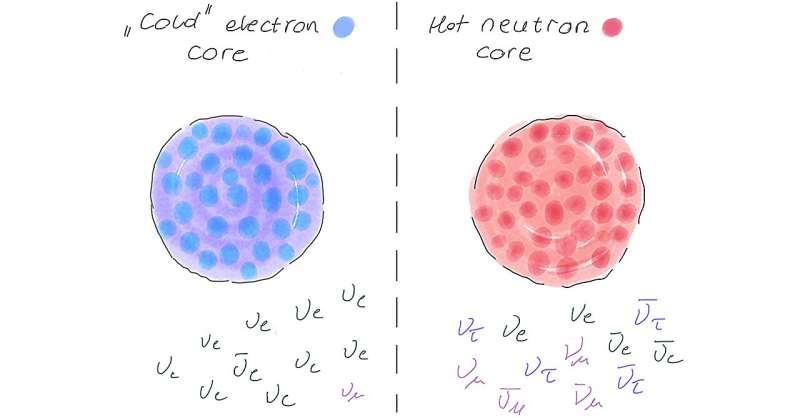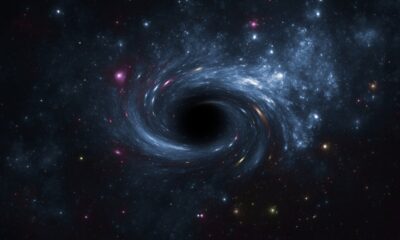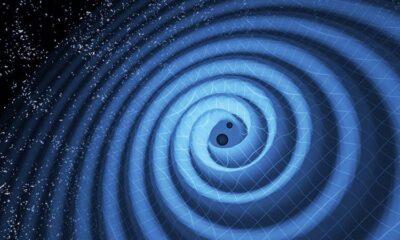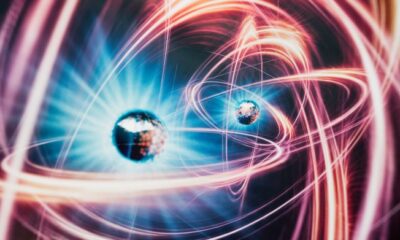Science
Study Reveals Neutrinos May Interact During Star Collapses

Research conducted by a team from the University of California – San Diego and the Network for Neutrinos, Nuclear Astrophysics, and Symmetries (N3AS) suggests that neutrinos, elementary particles known for their elusive nature, may interact in unexpected ways during the collapse of massive stars. The findings, published in Physical Review Letters on July 14, 2025, reveal that these interactions could significantly alter the fate of collapsing stars.
Neutrinos come in three distinct forms, known as flavors: electron, muon, and tau. Their fundamental properties remain largely enigmatic, particularly because laboratory conditions make it nearly impossible to observe their collisions directly. The research team, including lead authors Anna M. Suliga, Julien Froustey, Lukáš Gráf, Kyle Kehrer, and George Fuller, used theoretical calculations to demonstrate how collapsing stars can serve as a natural “neutrino collider.”
As massive stars undergo collapse, they experience extreme conditions that allow neutrinos to extract thermal energy from the stellar material. This process forces the stars to contract, driving their electrons to approach the speed of light. The instability that ensues can lead to a catastrophic collapse.
Potential Outcomes of Neutrino Interactions
The study indicates that as a star’s density increases during collapse, neutrinos may become trapped, resulting in collisions among themselves. Under standard model interactions, the neutrino flavor composition would predominantly be electron-flavored, leading to a relatively “cold” matter state and possibly leaving behind a neutron star remnant. In contrast, if secret interactions among neutrinos occur, the results are dramatically different.
Such interactions could create a diverse array of neutrino flavors and develop a “hot” core composed mainly of neutrons, which may ultimately result in the formation of a black hole remnant. The implications of these findings could reshape current understanding of stellar evolution and the end stages of massive stars.
Future experiments may provide further insights into these phenomena. The Fermi National Accelerator Lab is preparing for the Deep Underground Neutrino Experiment (DUNE), which aims to test these theories. Observations of neutrinos and gravitational waves from collapsing stars may also shed light on these interactions.
This research not only enhances the understanding of neutrinos but also opens doors to exploring fundamental questions in astrophysics. As scientists continue to unravel the mysteries of these elusive particles, the potential for groundbreaking discoveries remains high.
-

 Entertainment3 months ago
Entertainment3 months agoAnn Ming Reflects on ITV’s ‘I Fought the Law’ Drama
-

 Entertainment4 months ago
Entertainment4 months agoKate Garraway Sells £2 Million Home Amid Financial Struggles
-

 Health3 months ago
Health3 months agoKatie Price Faces New Health Concerns After Cancer Symptoms Resurface
-

 Entertainment3 months ago
Entertainment3 months agoCoronation Street’s Carl Webster Faces Trouble with New Affairs
-

 Entertainment2 months ago
Entertainment2 months agoWhere is Tinder Swindler Simon Leviev? Latest Updates Revealed
-

 Entertainment4 months ago
Entertainment4 months agoMarkiplier Addresses AI Controversy During Livestream Response
-

 Science1 month ago
Science1 month agoBrian Cox Addresses Claims of Alien Probe in 3I/ATLAS Discovery
-

 Entertainment4 months ago
Entertainment4 months agoKim Cattrall Posts Cryptic Message After HBO’s Sequel Cancellation
-

 Entertainment2 months ago
Entertainment2 months agoOlivia Attwood Opens Up About Fallout with Former Best Friend
-

 Entertainment3 months ago
Entertainment3 months agoMasterChef Faces Turmoil as Tom Kerridge Withdraws from Hosting Role
-

 Entertainment4 months ago
Entertainment4 months agoSpeculation Surrounds Home and Away as Cast Departures Mount
-

 World2 months ago
World2 months agoCole Palmer’s Mysterious Message to Kobbie Mainoo Sparks Speculation

















